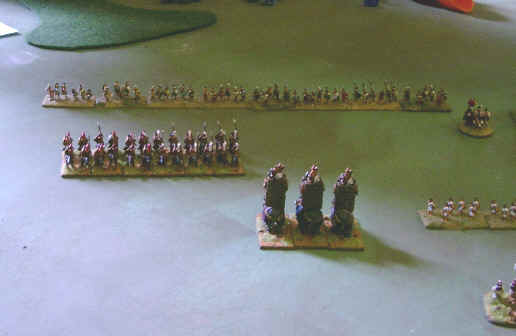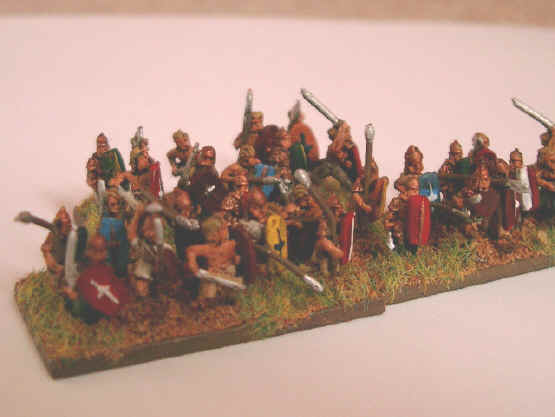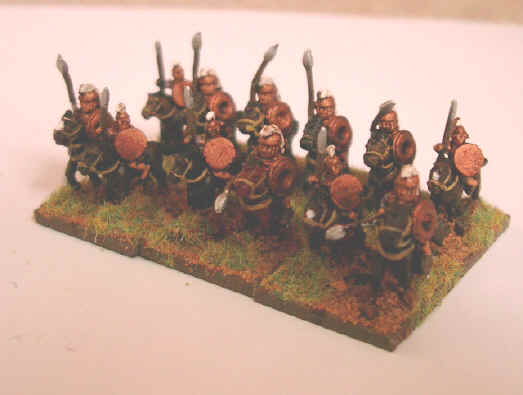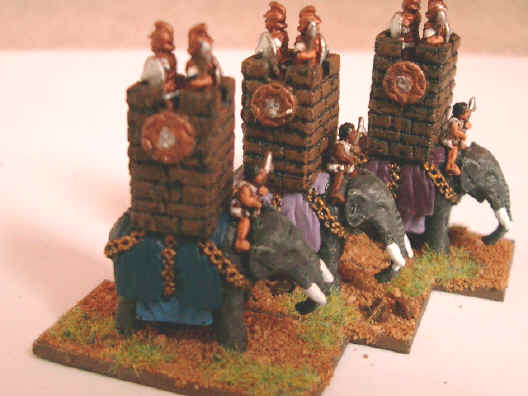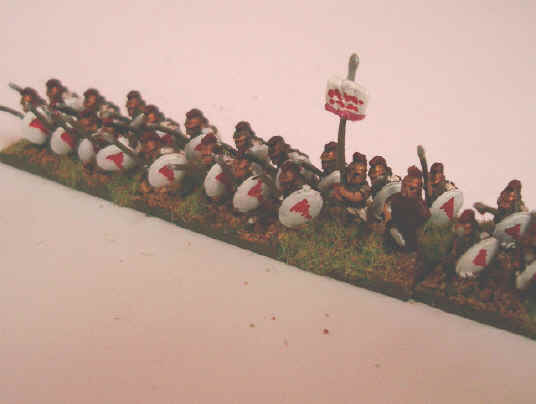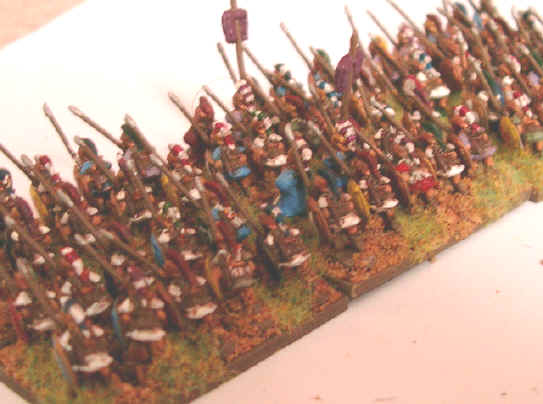Devizes Warhamster
Game 4
Game 4 saw me against an Alexandrian army, and needing to score huge points to overhaul the current leaders.
The army was
- 2 Generals
- 2 units of elite Pikemen
- 3 units of normal pikemen
- 2 units of spearmen
- 2 units of bowmen
- 4 units of 2-attack skirmishers - peltasts
- 2 units of shock cavalry Companions
I had played one game against Alexandrians with my army in practice, and my opponent then had struggled to get the phalanx into combat allowing me to dance around and chew up his flanks - in Warhamster a phalanx is one of the only troop types who don’t get total freedom to maneuver, as they only move half speed unless moving straight ahead.
Knowing the army was likely to have - and indeed did have - a large slow moving but tough foot centre, I realised the way to rack up maximum points was to systematically pick on the expendable troops (the skirmishers), then hunt down the high value troops (the 2 units of shock cavalry) before finally launching an assault on the phalanx - who I hoped to avoid by dodging around with my own close formation foot!
With the phalanx off to one side, the Alexandrians threw out a line of heavy duty (2 attack) skirmishing auxilia with their shock cavalry lurking behind. Spotting what appeared to be an opportunity I attempted to charge down the thin line of unsupported auxilia in the open with my own 2 attack (+ 1 charge) cavalry - but again, I failed to remember the impact of incoming shooting, this time with javelins, from the auxilia, putting them on 3-4 dice per base against my charging cavalry! I did some damage, but bounced off.
The main body of my foot were looking nervously at the phalanx, but they managed to secure a position up a hill staring down at the Greek stick-carriers, and then proceeded to dance left and right - my block of 8 units of foot 2 deep were 48cm wide, but were able to move at least 20cm sideways and backwards each turn to threaten alternate flanks of the confused mass of pikemen before them, who were 9 units strong, making command and control hard anyway, and who compounded their disarray with a series of poor command rolls and 2 blunders leading to further command penalties, leaving them immobilized and unable to press home.
My cavalry were then reduced to skirmishing and shooting against the auxilia line, and eventually my shock cavalry were called in to despatch the auxilia, but again the unsupported skirmishers laughed at the threat, and simply evaded away from my elite noblemen (the auxilia did enough shooting casualties to be able to evade).
I charged again, combining skirmish and shock cavalry AND elephants - and the combination meant I managed to pin the little dogs down - and once they were locked in place the phenomenal amount of additional dice the shock cavalry get meant I was able to explode a few units on a single turn.
This then opened up the field for another 2 turn / 8 combat domino style collapse as the Alexandrian Companions piled in, zapping my units but not eliminating them entirely and then in turn were overwhelmed by the arrival of my 3 elephants, who had just eaten 2 units of bowmen and then tipped the balance in the cavalry melee decisively - leaving my shattered, but undefeated cavalry the masters of all they surveyed. I had eliminated all the skirmishers, and 4 core units (2 bowmen, 2 shock cavalry) - leaving about 3 more units needed to break the Alexandrians. But killing 3 would not be enough - I had to mullah the entire phalanx in my final charge!
My massed infantry then decided it was time to advance down from the hill and slammed into the Alexandrian pikemen - flowing round their flanks as well as there was not enough room to fit in front. Fortunately there was no incoming shooting to spoil things for me this time, and I won the first round of melee - forcing the Pikemen back and severely damaging several units. In the second phase, selection of which units my men were concentrating their fighting against was crucial, as I needed to prolong the battle into another turn, so I had to make sure enough units survived to not break the army this time around! It just about worked, and the game continued, with many very battered Greek units hanging on reluctantly. More Greeks piled in and we fought again - but this time the combats were eliminating Greek units in sufficient numbers to allow me to destroy some units and then achieve a breakthrough charge - and gain 2 extra rounds of combat. The end result was that 5 units of pikemen were destroyed in the last round of combat - giving me full points for their demise, and tipping the Alexandrian army waaaaay over the 50% casualty mark.
With all the skirmishers gone, and with an excessive amount of core casualties including all their most expensive units, the scoreboard was whizzing round so fast the numbers were a blur. It was easier to count the survivors - a 960-point victory for me!
This massive total put me - marginally - ahead of the others in the chasing pack, and meant a trophy (with a "1" on it) in my 1st Warhamster competition.
So, Whaddya (I) Think?
I definitely enjoyed the competition, and there is clearly a good camaraderie and folklore already in the Warhamster world - but I'm still not sure what I think of the rules overall - as I'm not yet sure whether the differences to DBM were "better", "worse" or just "different"... and how much was me needing to unlearn DBM maxims, and how much is just a different world view by the authors.
The biggest difference comes down to that on a spectrum from "game" to "historical simulation" WMA is definitely closer to the "game" end of the spectrum than DBM - and it fully admits to be so. The simplicity (lack of rules restricting in any way!) movement makes the game flow differently, but does lead to quite a few "duh, like WHAT happened there!!" moments as blocks of troops slide and shuffle freely from side to side - which I was able to take advantage of against the Alexandrian pikemen, who were restricted to moving "more historically" and so could not deal with the rapid sideways and backwards redeployments of my warband and spear formations!
The other big issue is getting used to the multiple moves, and what this means for game play. With multiple-sequential move rulesets there is of course a rationalization that involved "pulses" of action (which I why I love the mechanic in Blitzkreig Commander, as for me it "works" in a WW2 context to simulate all sorts of things I have read in accounts and histories) - but in my mind Ancient warfare did usually mean plodding forwards and fighting in big lines rather than pulses of action and dramatic movement and then periods of inactivity. So, this, combined with the move distances involved in WMA and the lack of non-moving troops ability to respond does lead to some situations that stretched my - and my opponents - credibility as the game moved maybe a little too far from "simulation" and too far towards "game" - i.e. the Sarmatian Cavalry's mad charge across the front of my infantry line in Game 2 for example. Punishment for me leaving my flanks open - or odd mechanics - you decide !
I remain skeptical about the balance of effect of shooting - at long distance its fairly poor, but in combat it is highly significant - especially against infantry, which to me still seems counter-intuitive (bowmen should want to shoot at distance and avoid being charged by infantry..). But, is this just me having a DB-centric philosophy, and WMA is right - or was it even just managing the in-game tactics of charging into bowmen poorly ??
I was pleased with my decision to take the Carthaginian army, and I am totally sold on shock troops as being the decisive weapon and I feel sure my theory of "max shock troops, decent skirmishers you can afford to lose, cheap infantry to not fight with but to use as padding" worked out very well.
The downside (on army design, and with shock troops) was that it did lead to some very similar games, with a period of inconsequential shuffling about as I (or my opponent) "teed up" the shock troops, followed by 1 or 2 bounds of intense multi-unit, multi-pursuit combats that decided the game. There was not the sense of a battle "evolving" in the same way as DBM - and consequently no feeling of "hanging on", "one wing crumbling" or even trying and succeeding in "turning the tide" - basically you are the Tsunami or the deckchairs !!
The best evidence of this is that I often failed to take any photos as those key moments of the game were 4 consecutive rounds of melee that occurred almost out of the blue. In a way it was more like 6th edition with one monster charge causing a domino topple of morale tests rather than the gradual erosion of formations and armies in DBM - but at least in WMA the cause of defeat is units being killed in combat, not failing morale tests !
One upside from playing in the comp was that I can see that there are definitely more "complex interactions" between troop types than is at first apparent - although the paper-scissors-stone of DBM is still a fantastic facet of those rules that I cant help feeling would add to WMA if it coudl be introduced in some way. I can now also see that other types of army would "play" differently...but I am still struggling to see what you can do with "other troops" against the prospect of decent numbers of shock mounted as they are better in combat than almost anything, and their move distances mean they have a great ability to make well timed charges - so all you can do without having some of your own may well be to hope you survive by weight of numbers and then nail their flanks.
However, the one truly un-mitigated fantastic thing is how cute 10mm figures look. Its just a shame the game often doesn't give you time to capture them ! So here are some shot of some of mine back home..
To My bookshop of Warmaster Ancients Armies
To my 10mm WW2 kit picture directory
To my 10mm ACW kit picture directory



